Physics - Ch 66 Ch 4 Quantum Mechanics: Schrodinger Eqn (84 of 92) Transmission Coeff=? (2 of 6)
TLDRIn this online lecture, the focus is on calculating the transmission coefficient, which represents the probability of a particle passing through a barrier. The process involves solving a system of equations derived from boundary conditions, with the aim of eliminating constants B and C to express the transmission coefficient in terms of the amplitudes of oscillations in different regions. The lecture demonstrates how to solve for F using equations 3 and 4, and sets up the stage for the next step, which is to eliminate C by setting these equations equal to each other and solving for C in terms of D.
Takeaways
- 📚 The lecture focuses on calculating the transmission coefficient using boundary conditions and wave functions.
- 🔍 The process involves solving a set of equations with three functions that describe wave behavior across different regions.
- 💡 The constant B was previously eliminated from the equations by using its equivalent, which is C plus D minus a constant.
- 📈 Equations 3 and 4 are used to solve for the constant F, which represents the amplitude of oscillations in regions 1 and 3.
- 🌟 The transmission coefficient is the ratio of F squared to a squared, representing the probability of a particle passing through a barrier.
- 🔢 In solving for F, the third equation is manipulated to isolate F, resulting in a division by a term involving the exponential of I k1 L.
- 🔄 By setting the expressions for F from equations 3 and 4 equal to each other, we can solve for the constant C in terms of D.
- 📌 The next step is to eliminate C from the equations by expressing it as a function of the constant D.
- 🎓 The lecture series will continue in the next video, where the process of eliminating C and solving the equations will be completed.
- 🤔 The mathematical process involves careful manipulation of exponential terms and factoring to simplify the equations.
- 📊 The final goal is to understand the quantum mechanical behavior of particles in the context of potential barriers.
Q & A
What is the main goal of the lecture?
-The main goal of the lecture is to find the transmission coefficient by analyzing the boundary conditions and equations related to wave functions and amplitudes across different regions.
What is the significance of the transmission coefficient in this context?
-The transmission coefficient represents the probability of a particle making it through a barrier, which is a crucial concept in quantum mechanics.
How many regions are considered in this lecture for the wave functions?
-Three regions are considered: Region 1, where the amplitude of oscillations is represented by 'a', and Region 3, where the amplitude is represented by 'F'.
What was the first step in the previous video that was mentioned in the transcript?
-The first step in the previous video was to eliminate the constant 'B' by using its equivalent 'C plus D minus' and plugging it into the equations.
What does the term 'e to the I k1 L' represent in the equations?
-'e to the I k1 L' represents an exponential term in the equations, which is part of the mathematical formulation used to describe wave behavior in different regions.
How are equations 3 and 4 used to solve for 'F'?
-Equations 3 and 4 are solved for 'F' by isolating 'F' on one side of each equation, then setting the right sides equal to each other to find the relationship between the constants 'C' and 'D'.
Why is it necessary to solve for 'C' in terms of 'D'?
-Solving for 'C' in terms of 'D' allows for the elimination of 'C' from the equations, simplifying the process of finding the transmission coefficient.
What happens when you factor out a negative 'L' from the exponents in the equations?
-Factoring out a negative 'L' from the exponents simplifies the equations, resulting in expressions that are easier to manipulate and solve for the constants.
What is the next step after solving for 'F' using equations 3 and 4?
-The next step is to set the two equations equal to each other to solve for 'C' in terms of 'D', which will then allow for the elimination of 'C'.
How does the process of eliminating constants help in understanding the transmission coefficient?
-Eliminating constants simplifies the mathematical model, making it easier to calculate the transmission coefficient and understand the probability of a particle passing through a barrier.
What is the role of the constants 'alpha' and 'I K 1 L' in the equations?
-The constants 'alpha' and 'I K 1 L' are coefficients in the equations that represent specific physical quantities or parameters related to the wave function behavior in the given regions.
Outlines
📚 Introduction to Transmission Coefficient Calculation
This paragraph introduces the goal of the lecture, which is to calculate the transmission coefficient. It explains the process of using boundary conditions and three functions to reach regions 1, 2, and 3. The paragraph also discusses the previous elimination of constant B and the current focus on solving equations for constant F, which represents the amplitude of oscillations in different regions and is crucial for determining the transmission coefficient, representing the probability of a particle passing through a barrier.
Mindmap
Keywords
💡Transmission Coefficient
💡Boundary Conditions
💡Wave Functions
💡Quantum Mechanics
💡Amplitude of Oscillations
💡Potential Barrier
💡Equations
💡Constants
💡Factoring
💡Exponential Functions
💡Tunneling
Highlights
The lecture focuses on finding the transmission coefficient.
The process starts with boundary conditions on both sides of the barrier.
Three functions are used, reaching from region 1, 2, and 3.
In the previous video, constant B was eliminated from the equations.
Equations 3 and 4 will now be used to solve for F.
F is a constant representing the amplitude of oscillations in region three.
The ratio of the squared amplitudes is the transmission coefficient.
The transmission coefficient is also the probability of a particle making it through the barrier.
Equation 3 is solved for F, resulting in an expression involving e to the power of I k1 L.
Equation 4 is also solved for F, with a similar process.
The two equations for F are then set equal to each other to solve for C in terms of D.
By setting the equations equal, we can eliminate the constant C by replacing it with its equivalent function of D.
The process involves factoring out negative L from the exponential terms.
The end goal is to simplify the equations to understand particle transmission through the barrier.
The lecture is part of a series, with the continuation to be covered in the next video.
The mathematical approach is based on solving a system of equations for specific constants.
The transmission coefficient has practical applications in quantum mechanics.
Transcripts
Browse More Related Video
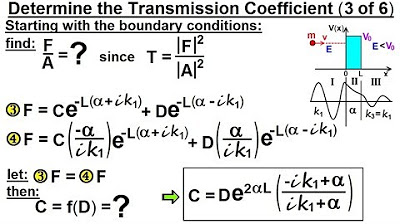
Physics - Ch 66 Ch 4 Quantum Mechanics: Schrodinger Eqn (85 of 92) Transmission Coeff=? (3 of 6)
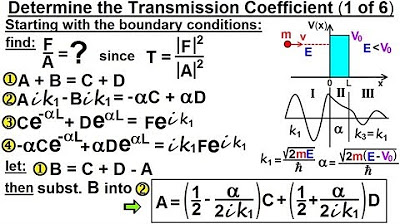
Physics - Ch 66 Ch 4 Quantum Mechanics: Schrodinger Eqn (83 of 92) Transmission Coeff=? (1 of 6)
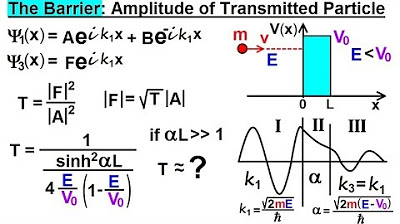
Physics - Ch 66 Ch 4 Quantum Mechanics: Schrodinger Eqn (78 of 92) The Barrier: Amplitude
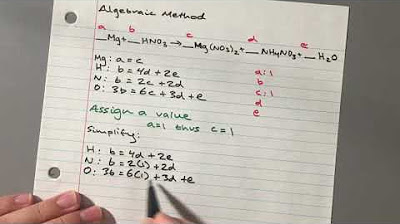
Algebraic Method for Balancing Chemical Equation
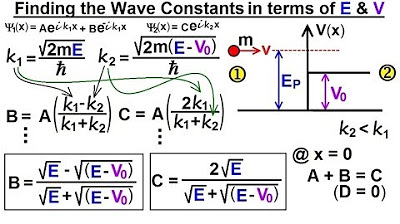
Physics - Ch 66 Ch 4 Quantum Mechanics: Schrodinger Eqn (66 of 92) B=? C=? in terms of E & V0

Physics - Ch 66 Ch 4 Quantum Mechanics: Schrodinger Eqn (72 of 92) R=? T=? V0=(1/4)E (Ex. 2 of 4)
5.0 / 5 (0 votes)
Thanks for rating: